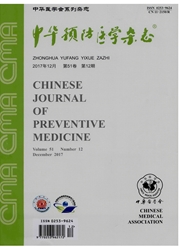

 中文摘要:
中文摘要:
目的研究广东地区家族性鼻咽癌患者与散发性鼻咽癌患者发病因素间存在的差异及其一级亲属恶性肿瘤发病情况,为鼻咽癌患者家庭成员的遗传咨询和筛查策略提供依据。方法选取2005年10月至2007年10月中山大学肿瘤防治中心收治的广东籍新发鼻咽癌患者作为研究对象,共收集1877例鼻咽癌患者,包括181例家族性鼻咽癌患者和1696例散发病例。对两组患者的人口学特征、临床特征、危险因素及一级亲属肿瘤家族史进行比较分析,并对家族性鼻咽癌患者受累一级亲属的分布及其与先证者发病的时间间隔进行分析。结果1877例鼻咽癌患者中181例(9.64%)有一级亲属受累;在受累的一级亲属中有58.49%(124/212)为同胞,41.51%(88/212)为父母。同胞与先证者发病的时间间隔为(7.40±5.41)年,而父母与先证者发病的平均时间间隔为(15.55±10.61)年,两者间差异有统计学意义(t=-5.78,P〈0.01)。两组患者确诊时80%以上临床分期已进入晚期(Ⅲ期以上)。无论是患病前还是儿童时期,两组在咸鱼(OR=1.01;95%CI:0.59~1.75VSOR=1.31;95%CI:0.92~1.86)、腌菜(OR=0.93;95%CI:0.58~1.49vs OR=1.12;95%CI:0.80~1.57)、酱类(OR=0.37;95%CI:0.14~1.01vs OR=1.61;95%CI:0.99~2.48)、新鲜水果(OR=0.87;95%a:0.60~1.26vs OR=0.65;95%CI:0.20~2.12)、腊味(OR=1.26;95%CI:0.87~1.83 vs OR=1.28,95%CI:0.71~2.30)等饮食因素方面差异均无统计学意义(P值均〉0.05)。两组患者在吸烟(OR=0.99;95%CI:0.68~1.45)及其一级亲属患其他肿瘤的风险方面(OR=0.85;95%CI:0.56~1.28)差异也无统计学意义(P值均〉0.05)。结论在中国广东地区的鼻咽癌患者中,家族性鼻咽癌约占9.64%。在高发家系中,同胞
 英文摘要:
英文摘要:
Objective To explore the difference between familial and sporadic nasopharyngeal carcinoma patients on risk factors and family history and provide evidence on genetic counseling and screening strategy for relatives of nasopharyngeal carcinoma patients in Guangdong province. Methods The Cantonese nasopharyngeal carcinoma patients diagnosed in Cancer Center, Sun Yat-sen University from October ,2005 to October ,2007 were recruited as subjects. 1877 patients were collected, including 181 familal nasopharyngeal carcinoma patients and 1696 sporadic nasopharyngeal carcinoma patients. The demographic characteristics, clinical characteristics, risk factors and family history between two groups were compared. Moreover,the distribution of nasopharyngeal carcinoma patients in first-degree relatives and the time interval between proband and the affected first-degree relatives in familial nasopharyngeal carcinoma patients was analyzed. Results All 9. 64% of 1877 nasopharyngeal carcinoma patients had affected relatives in first-degree relatives, among them, 58.49% ( 124/212 ) were siblings and 41.51% ( 88/212 ) were parents. The mean time interval between siblings and proband were (7.40±5.41 ) years while the mean time interval between parents and proband were (15.55±10. 61 ) years when nasopharyngeal carcinoma occurred, and the difference was statistically significant (t = -5.78, P 〈 0. 01 ). More than 80% patients of the two group were at advanced stage when they were diagnosed. There were no difference ( P values were all 〉0. 05) both in adulthood and childhood in salted fish( OR = 1.01 ;95% CI:0. 59 - 1.75 vs OR = 1.31 ; 95% CI:0. 92 - 1.86) ,preserved vegetables (OR = 0. 93;95% CI:0. 58 - 1.49 vs OR= 1.12;95% CI: 0. 80 - 1.57 ), fermented pastes ( OR = 0. 37 ; 95% CI: 0. 14 - 1.01 vs OR = 1.61 ; 95% CI: 0. 99 - 2. 48 ), fresh fruits ( OR = 0. 87 ;95 % CI: 0. 60 - 1.26 vs OR = 0. 65 ; 95 % CI: 0. 20 - 2. 12 ) and cured meat ( OR = 1.26 ;95 % CI:0. 87 - 1.83
 同期刊论文项目
同期刊论文项目
 同项目期刊论文
同项目期刊论文
 Antibodies against Epstein-Barr virus gp78 antigen: a novel marker for serological diagnosis of naso
Antibodies against Epstein-Barr virus gp78 antigen: a novel marker for serological diagnosis of naso Clinical values of multiple Epstein-Barr virus (EBV) serological biomarkers detected by xMAP technol
Clinical values of multiple Epstein-Barr virus (EBV) serological biomarkers detected by xMAP technol Evaluation of a multianalyte profiling assay and an enzyme-linked immunosorbent assay for serologica
Evaluation of a multianalyte profiling assay and an enzyme-linked immunosorbent assay for serologica 期刊信息
期刊信息
